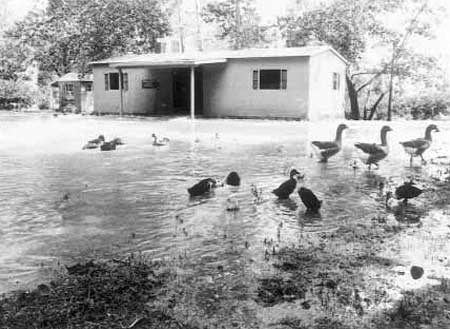|
PIPE SPRING
Cultures at a Crossroads: An Administrative History |

|
PART X - PIPE SPRING NATIONAL MONUMENT COMES ALIVE (continued)
Flood Diversion, Irrigation, and Pipelines
As in previous years, every few years or so either the Tribe's or the stockmen's pipelines would get clogged with roots or leaves and require cleaning out. The stockmen's pipeline was in poor condition when Bozarth inspected it in February 1964. The line showed leaks and lack of maintenance. In February 1965 the stockmen asked the Bureau of Land Management to replace the old rusted-out pipeline that conveyed water from Pipe Spring to their grazing leases three to four miles south of the monument. They informed Bozarth in July that a replacement water line was planned, but because the stockmen disagreed among themselves, nothing was done that summer. Bozarth thought the trouble was that the stockmen were unwilling to foot the bill, wanting the new pipeline to be paid for by a government agency (in this case, either the BIA or NPS). In January 1966 Hopi Agency surveyors staked the route for the replacement pipeline. In March a new two-inch plastic pipeline was installed across the monument to take the place of the stockmen's old line. The old line wasn't removed on the monument, rather the smaller plastic pipe was pushed through the larger old line. Once on the reservation, a 1.5-inch line was laid three feet deep; stockmen installed the two-mile line in two days.
Some measures were taken during the 1960s to prevent future flooding at the monument, since the 56-inch drainage culvert had proved inadequate. A new culvert was installed in April 1964. Ray Mose added ornamental rockwork to hold soil behind the culvert wings. In June 1965 Mose built a rock wall about 30 feet long (to hold run-off water to its channel in the main wash), which also improved the look of the culvert wings.
Floods
On August 30, 1969, heavy rain caused flooding, resulting in damages on the monument. The area around the visitor contact station and comfort station was flooded. Emergency funds were made available to have the storm damages repaired under contract in October. The 58 x 26-inch culvert pipe was placed, the drainage channel widened, and flood debris was cleaned up. [2092] A similar problem, but less severe, was experienced in early September.

122. Visitor contact station after a flood, August 1969
(Pipe Spring National Monument).
| <<< Previous | <<< Contents >>> | Next >>> |
pisp/adhi/adhi10q.htm
Last Updated: 28-Aug-2006